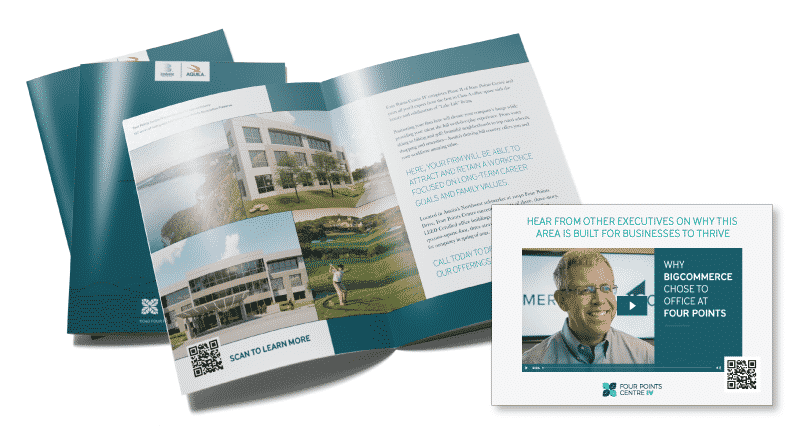Commercial real estate marketing has evolved and improved over the past year. We’ve seen trends like virtual tours, virtual events and more becoming increasingly prevalent this year. But what core shifts in commercial real estate marketing have been taking place?
In this article, Ashley Jones, Marketing Manager at Brandywine Realty Trust in Austin, outlines and explains how you can take advantage of the major shifts happening now in commercial real estate marketing.
My team hears me say this all too often, so forgive me, but for those in the back: It’s truly an exciting time to be a marketer in the commercial real estate industry. Our industry is ripe for innovation across multiple disciplines and it’s thrilling to reimagine how we do business. From implementing augmented reality in construction, to walking prospects through a virtual tour, there are endless ways of optimizing our traditional job functions to deliver value for clients.
Read Next: The Ultimate Guide to Commercial Real Estate Marketing
How exactly can we leverage marketing tactics to generate more valuable outputs for commercial real estate? As you build out your 2021 budgets and strategies, let’s explore three key shifts and how they can be applied in the CRE space.
1. Adoption of Account-Based Marketing in Commercial Real Estate
According to all-knowing Google, Account-Based Marketing (ABM) is a strategic approach to business marketing based on account awareness, in which an organization considers and communicates with individual prospect or customer accounts as markets of one.
For us, it means flipping the typical ways of prospecting upside down, and making marketing and leasing teams work in unison with the ultimate goal of customer acquisition. Included below is a graphic to articulate the difference between traditional methods and ABM.

Image Source: Ashley Jones
There are a few ways you can adopt this methodology, organized by low to high:
Shift and tailor all messaging to the end-user versus the tenant rep broker
For some of us, this is old news, but you’d be surprised how often marketing collateral misses opportunities to speak directly to the decision-maker. Think of it this way: would you market a new wedge to the caddy, or to Masters Champion Dustin Johnson? You’d tailor it to the person actually swinging the club. If you don’t tailor your message to your end-user decision-maker, you miss your shot to really speak their language.
Identify a few key profiles (in general terms) for your ideal tenant and customize your message to these profiles
If your asset has an anchor tenant, and a smaller space available, consider tailoring your message to a complementary industry that values proximity to its clients. This is a tactic commonly used in retail by shopping mall owners. If you’re looking for a bigger fish and the top 10 deals in the market are 75% professional services, create custom materials based on why your asset would optimize their business models.
Create avenues/mechanisms to advise who is interested in your project
Yes, marketing can surface demand trend lines, too. Allocate budget line items for ad placements capturing the attention of your target market, then analyze trend lines. You may start to see what industries and who (titles/rank) are engaging with your content before there’s an active deal in the market. With this data in hand, you’re poised to provide valuable insight into leasing.
Read Next: Best Places to Advertise Your Commercial Property
Put money into a Customer Relationship Management (CRM ) tool
We’ve recently leveraged Hubspot to provide more valuable insight into the lifecycle of customer acquisition and beyond. At a minimum, a CRM can establish a foolproof way to consistently and creatively check in with your list of prospects. On the higher end of the opportunity, a CRM tool can advise your team (in real-time) where your prospect sits in the acquisition lifecycle.
With data at everyone’s fingertips, we will certainly see a shift to highly-customized and strategic approaches to prospecting in our space versus a “spray and pray” mentality from the past.
2. Shifting Marketing Dollars from Print to Digital
For many years, marketing dollars have been pumped into static materials to yield high-impact first impressions. Let’s pick on costly print brochures.
Printed brochures can make a strong first impression with high-gloss overlays on matte covers, debossed logos, and custom-cut pages. However, like brand-new cars, what happens when it drives off the lot? Its value instantly depreciates. You’ll see these brochures left behind at events, lining recycling bins, and quickly becoming inaccurate with outdated information. Even more, there are no data to be gleaned from them to advise sales teams on prospects or trends.
As we discussed in ABM, we’re going to be constantly looking for insight into prospects, and static materials can rarely provide valuable data points to advise sales teams.
There’s no question—high-quality print materials are here to stay because first impressions are important. So, how do you make a stellar impression AND extend the life of static materials? Here’s where the fun begins! I’d recommend allocating a portion of this line item to build in digital features that provide insight to your sales/leasing team:
Leverage a simple QR code to access dynamic, expanded information
Do you have a 360 panoramic rendering that simply can’t be experienced in a static environment? Utilize it by adding a QR code to printed materials. Not only can you keep your audience engaged (an important step in ABM), but you can also build out a tracking code to track views.

QR codes are a low-cost way to extend the life and value of static print materials.
Implement a digital marketing strategy
Ever wonder why you see that Callaway ad on your phone or computer when you were just looking for a new pair of golf shoes? Welcome to the wild world of digital marketing. I use the term “digital marketing” broadly here as it could be a blog post all on its own.
Clients are now becoming tech-savvy, and digital marketing allows you to find them at the right time and in places they are already engaged. You can custom tailor messaging and choose a particular audience to target, so, like the Callaway ads you keep seeing across your screens, you can easily kick off your customer journey.
Leverage immersive experiences for the to-be-built world. For the built environment, it’s easy to visit the project and experience it first-hand. However, for yet-to-be-developed projects, oftentimes clients have a hard time visualizing the final product. Sure, renderings certainly can paint a picture, but if you want to really wow prospects, leverage some unique 3D tech. Check out an interactive site map for a large-scale development project or virtual tours for a specific suite.
For 2021, evaluate your current static materials and think through how you can make them work harder, so you can work smarter.
3. Enhanced Expectations for Real Estate Marketing Reporting
In the past, we’ve held low expectations around reporting on marketing performance. It’s time to expect more from reporting, particularly as it relates to ROI.
I’m a fan of the following important KPIs (key performance indicators aka goals):
Awareness. How many people have seen your project across all mediums?
Engagement. Who has seen your collateral, and went a step further to engage with it?
Lead generation. Who has viewed your materials, engaged, and reached out for additional information?

Image Source: Ashley Jones
Bonus reporting measurement: Customer acquisition
Our industry often takes a while to close a deal, and the nuances in getting from marketing campaign to transaction are slow and complicated, thus making it tough to really understand the cost of customer acquisition in marketing terms. However, the belief in achieving this calculation should be on your radar for 2021.
Marketing has long been considered a cost center versus a revenue generator. We can change that by implementing a comprehensive reporting framework to track tactics, inform strategy, and measure ROI. As we enter into 2021 with many unknowns, plant the seeds to begin to understand your successful campaigns, and get ready to accelerate once the results come in.

With 2020 almost in hindsight, and the excitement 2021 brings, use the next few weeks to evaluate and reflect on your current materials, and perhaps you can find ways to implement some of the above tactics to drive value to your organization.
To continue learning about marketing your commercial property, check out these articles:
- Virtual Tours for Your Commercial Property: Everything You Need to Know
- How to Use Advertising to Market Your Commercial Property
- Videos You Should Be Using to Market Your Commercial Real Estate Property (Examples)
- Best Branding Agencies for Commercial Real Estate Property
- Guide to Building an Effective Marketing Center for Your Commercial Property
- How to Market a Commercial Property: Essential Tools Your Leasing Firm Should Provide














